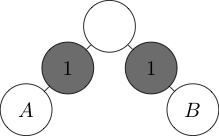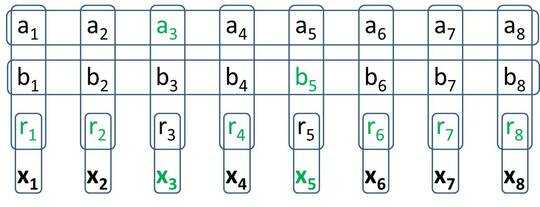12
1
As we saw in this question complex logical statements can be expressed in terms of the simple connectives of generalized Minesweeper. However Generalized minesweeper still has redundancies.
In order to avoid these redundancies we define a new game called "Generalized-1 Minesweeper".
Generalized-1 Minesweeper is a version Minesweeper played on an arbitrary graph. The graph has two types of vertex, an "indicator" or a "value". A value can be either on or off (a mine or a dud) however its state is unknown to the player. An indicator tells that exactly one of the adjacent cells is on (a mine). Indicators do not count as mines themselves.
For example the following board for Generalized Minesweeper tells us that cells A and B are either both mines or neither of them are mines.
(In the diagram indicators are marked in gray while values are white)
Unlike in normal minesweeper where you click values that are off to reveal indicators, there is no such mechanic in Generalized Minesweeper. A player simply determines for what states of the graph can satisfy its indicators.
Your goal is to make a 2 in Generalized-1 Minesweeper.
You will build a structure in Generalized-1 Minesweeper such that there are 8 specific cells for which all possible configurations of values have exactly two cells on. This means it behaves exactly as the 2 does in traditional minesweeper. When you write your solution you should not have specific values in mind for value cells. (In answer to H.PWiz's question it is allowed that some value cells might be deducible from the state)
Scoring
You answers will be scored by the number of vertices in the final graph minus 8 (for the 8 inputs) with a lower score being better. If two answers tie in this metric the tie breaker will be the number of edges.



Does any edge always connect an indicator vertex and a value vertex? – xnor – 2018-01-31T22:15:30.873
@xnor In order to maximize your score they ought, but I don't feel like I need to make that a rule. Edges that don't connect values to indicators don't change the behavior of the graph. – Post Rock Garf Hunter – 2018-01-31T22:16:13.057
When 6 is subtracted from the score, what are the 6 inputs? Aren't there 8 cells? – xnor – 2018-01-31T22:21:45.917
@xnor Sorry should be 8. Fixed now. – Post Rock Garf Hunter – 2018-01-31T22:22:54.673
What do you mean by "structure...such that there are 8 specific cells that the only possible configurations of values have exactly two cells on."? Are the only possible configurations supposed to have only two mines? – dylnan – 2018-01-31T23:06:05.793
@dylnan You should be building a graph such that for 8 of its value cells (you choose which) exactly 2 of them must be mines, and any two of them can be mines. The graph can have other helper value cells as well but we are only concerned with the behavior of 8 of the graph's cells. Does that clarify? I can help if you have any further specific questions. – Post Rock Garf Hunter – 2018-01-31T23:09:02.707
Thanks, that does help. Is it required that any possible choice of two cells being mines (in the set of 8) satisfies the graph? – dylnan – 2018-01-31T23:22:40.367
@dylnan Yes it is. – Post Rock Garf Hunter – 2018-01-31T23:33:04.297
I'm not convinced that, in this case,
you can always improve your score by removing such cells. This is certainly true when you can just change the indicator cell attached, but here there is only one kind of indicator cell – H.PWiz – 2018-02-01T00:09:13.503@H.PWiz You might be correct. I'll see about verifying this fact but until then I will remove the comment. – Post Rock Garf Hunter – 2018-02-01T00:11:54.743
@H.PWiz The only reason that can't be reduced is because you can deduce the value of the input cells. I think that we can actually can remove deducible cells as long as they do not also deduce our input cells. – Post Rock Garf Hunter – 2018-02-01T00:18:32.900